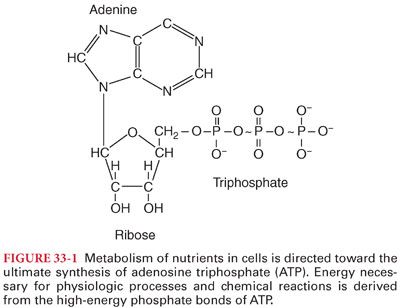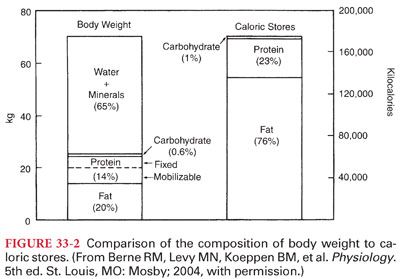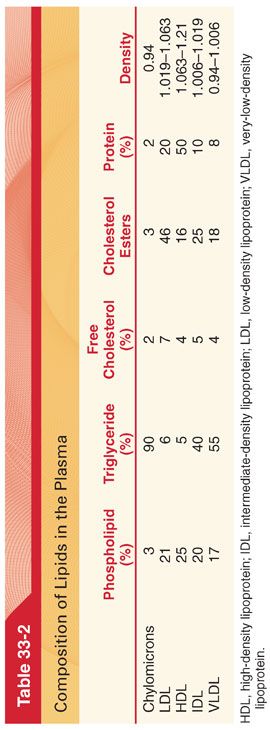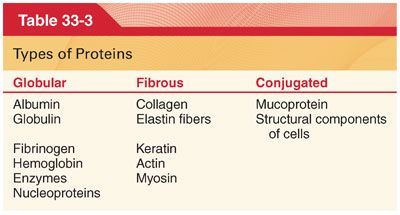

II. Carbohydrate Metabolism. Carbohydrates comprise a group of organic compounds that include sugars and starches and, in addition to carbon, contain hydrogen and oxygen in the same ratio as water (2:1). Sugars are an important energy source for the body and the sole source of energy for the brain. The liver is the site of carbohydrate metabolism where regulation storage and production of glucose takes place.
A. Glycogen
1. After entering cells, glucose can be used immediately for release of energy to cells or it can serve as a substrate for glycogen synthase.
2. The liver and skeletal muscles are particularly capable of storing large amounts of glycogen but all cells can store at least some glucose as glycogen. The liver stores glycogen for release of glucose during fasting, and muscle, which can store as much as 90% of the glucose contained in a meal, catabolizes glycogen during strenuous exercise.
B. Gluconeogenesis is the formation of glucose from amino acids and the glycerol portion of fat. Gluconeogenesis is stimulated by hypoglycemia.
C. Energy Release from Glucose
1. Glucose is progressively broken down into two molecules of pyruvate, both of which can enter the citric acid cycle.
2. The most important means by which energy is released from the glucose molecule is by glycolysis (splitting of the glucose molecule and subsequent oxidative phosphorylation). Oxidative phosphorylation occurs only in the mitochondria and in the presence of adequate amounts of oxygen.
D. Anaerobic Glycolysis
1. In the absence of adequate amounts of oxygen, a small amount of energy can be released by anaerobic glycolysis (glucose is the only nutrient that can serve as a substrate for the formation of ATP without oxygen).
2. Severe liver disease may interfere with the ability of the liver to convert lactic acid to glucose, leading to metabolic acidosis.
III. Lipid Metabolism
A. Lipids contain a high amount of potential energy, but are also important as structural components of cell membranes, in signaling pathways, and as precursors to a number of cytokines.
B. A glycerol stem to which three fatty acid molecules are bound is known as a triglyceride. A triglyceride molecule to which one of the terminal fatty acids is replaced with a phosphate ion is known as a phospholipid. Phospholipids are the building blocks of cell membranes and myelin.
1. Triglycerides, after absorption from the gastrointestinal tract, are transported in the lymph and then, by way of the thoracic duct, into the circulation in droplets known as chylomicrons.
2. Triglycerides are used in the body mainly to provide energy for metabolic processes similar to those fueled by carbohydrates.
C. Molecules that are part lipid and part protein, lipoproteins, are also synthesized primarily in the liver (Table 33-2).

1. All the cholesterol in plasma is found in lipoprotein complexes, with low-density lipoproteins (LDLs) representing the major cholesterol component in plasma.
2. These LDLs provide cholesterol to tissues, where it is an essential component of cell membranes and is used in the synthesis of corticosteroids and sex hormones.
3. An intrinsic feedback control system increases the endogenous production of cholesterol when exogenous intake is decreased, explaining the relatively modest lowering effect on plasma cholesterol concentrations produced by low-cholesterol diets.
a. If endogenous increase in cholesterol synthesis is blocked by drugs that inhibit hydroxymethylglutaryl coenzyme A (HMG-CoA) reductase, then there is an appreciable decrease in the plasma cholesterol concentration.
b. Drugs that selectively inhibit HMG-CoA are known as statins (effectively lower plasma LDL cholesterol concentrations and seem to provide protection against acute cardiac events, perhaps reflecting antiinflammatory effects).
IV. Protein Metabolism (Table 33-3). All proteins are composed of the same 20 amino acids, and several of these must be supplied in the diet because they cannot be formed endogenously (essential amino acids) (Table 33-4). Amino acids are relatively strong acids and exist in the blood principally in the ionized form.

Stay updated, free articles. Join our Telegram channel

Full access? Get Clinical Tree


